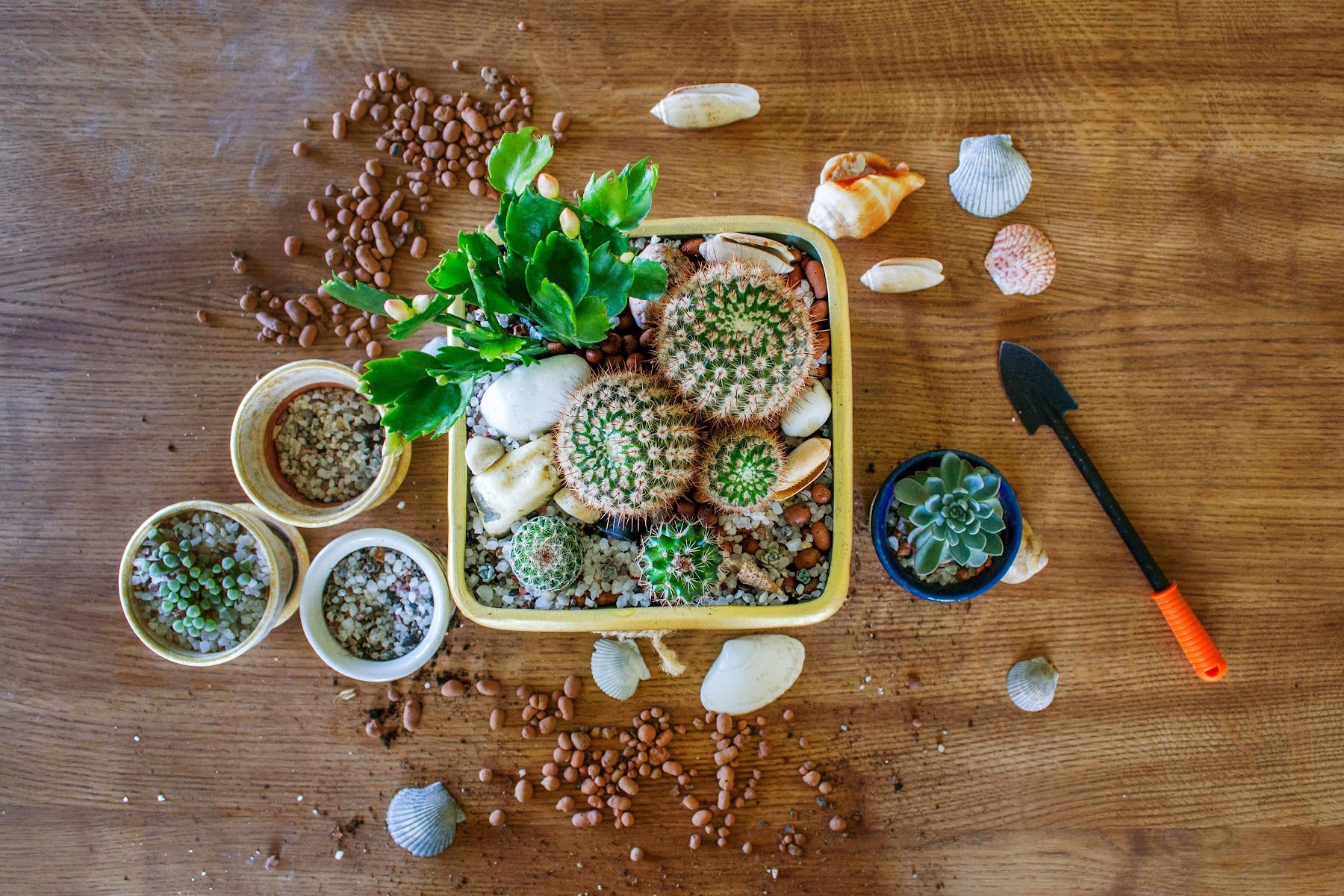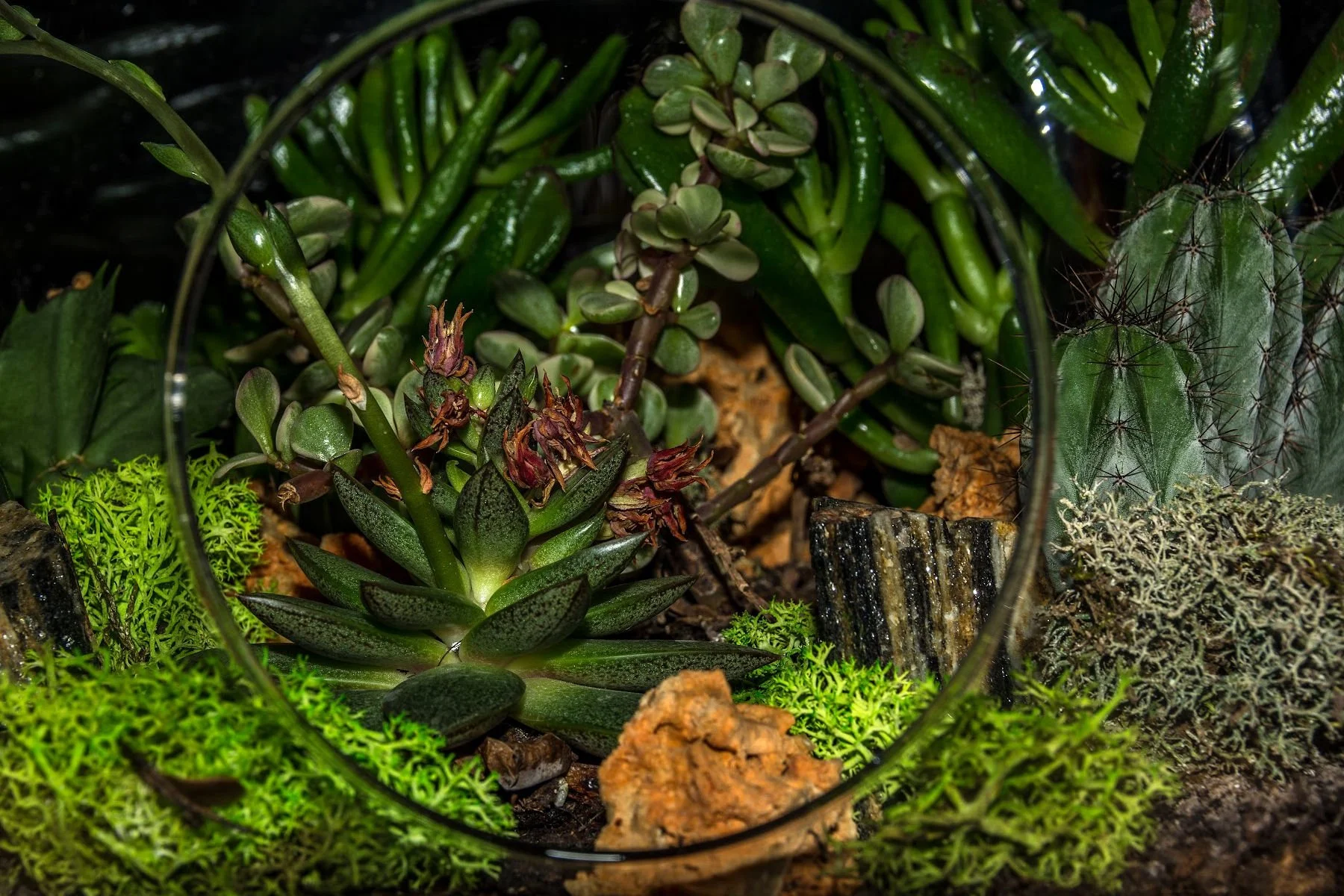Tips for Caring for your Terrarium
Let me tell you a little secret: I'm a proud terrarium enthusiast. There, I said it! Now, before you start picturing me as some sort of mad scientist surrounded by glass jars filled with tiny plant worlds, let me assure you - I'm just a regular person who loves bringing a slice of nature indoors. And if you're reading this article, I bet you're curious about the magical world of terrariums too.
So, what is a terrarium, you ask? Picture this: a miniature garden enclosed in a glass container, creating its own little ecosystem. It's like having a piece of the great outdoors right on your windowsill or office desk. Not only do terrariums add a touch of greenery to your space, but they also serve as a relaxing hobby that lets you unleash your creativity and connect with nature.
In this article, I'll be sharing my tried-and-tested tips for caring for your very own terrarium. From choosing the perfect container to troubleshooting common issues, I've got you covered. So grab your gardening gloves, and let's dive in!
Choose the Right Container
The first step in creating your very own terrarium wonderland is selecting an appropriate container. This is where your plants will call home, so it's important to pick something that suits their needs and your personal style.
There are two main types of terrariums: open and closed. Open terrariums have no lid, allowing air to circulate freely. These are great for plants that prefer a drier environment, like succulents and cacti. On the other hand, closed terrariums have a lid or cover, trapping moisture inside and creating a humid environment perfect for tropical plants like ferns and mosses.
As for the container itself, the options are endless! You can use anything from a simple glass jar to a fancy fish tank or even a repurposed lightbulb (I know, right?). Just make sure it's transparent so that light can reach your plants and has enough space for them to grow. Remember, the container is the stage for your mini-garden masterpiece, so don't be afraid to get creative!
Select the Right Plants
Alright, let's talk plants! Choosing the right plants for your terrarium is like casting the perfect actors for a movie – you want them to have great chemistry and work well together in their new environment. Plus, just like any Hollywood blockbuster, you want your terrarium to be visually stunning too. So, how do you pick the right stars for your show?
First, consider the conditions inside your terrarium. Is it open or closed? This will dictate whether you need plants that thrive in drier environments (open terrariums) or those that love humidity (closed terrariums). It's important to match the plant's needs with the terrarium environment, or you'll end up with a sad-looking mini-garden (and nobody wants that!).
Now, let me share some of my favorite terrarium plants with you. For open terrariums, I absolutely adore succulents and cacti. They're like the cool kids of the plant world – low maintenance, super stylish, and always ready for their close-up. Plus, there are so many varieties to choose from; you can mix and match to create your own unique landscape.
For closed terrariums, I'm all about ferns and mosses. They're like the cuddly teddy bears of the plant kingdom – soft, lush, and oh-so-comfy. Some of my go-to ferns include the maidenhair fern and the button fern, while for mosses, I love mood moss and sheet moss. And don't forget about tropical plants like the nerve plant and the polka dot plant – they add a pop of color and drama to your terrarium.
Here's a little anecdote for you: When I first started building terrariums, I tried putting a cactus and a fern together in a closed container (rookie mistake!). As you can probably guess, it didn't end well. My cactus became a soggy mess, and the fern looked like it was auditioning for a role in a horror movie. Lesson learned: always match your plants' needs with the terrarium environment!
So, now that you've got a stellar cast of plants, it's time to create the perfect home for them. And that starts with laying the foundation – literally! Let's move on to the next step: layering your substrate.
Layer Your Substrate
Picture this: you've just found the perfect apartment, but there's one tiny problem – it doesn't have any floors! Well, that's pretty much what your terrarium would be like without a proper substrate. So let's get down to business and build a solid foundation for your plants to thrive.
Now, I know what you're thinking: "Substrate? Isn't that just a fancy word for dirt?" You're not entirely wrong, my friend, but there's more to it than that. A healthy terrarium needs a few layers of different materials to create the ideal environment for your plants. Let me walk you through it step by step, just like I did when I built my very first terrarium (and trust me, I've come a long way since then).
Step 1: The Drainage Layer
First things first, we need a drainage layer. This is like the basement of your terrarium, where excess water can escape and avoid turning your plants into a soggy mess (remember my cactus-fern disaster? Yeah, we don't want that). For this layer, you can use small stones, pebbles, or even broken pieces of terracotta pots. Just make sure they're clean and free of any chemicals. Aim for a layer about 1-2 inches thick, depending on the size of your container.
Step 2: The Charcoal Layer
Next up, we have the charcoal layer. Now, you might be wondering why on earth we need charcoal in a terrarium – are we trying to grill some veggies in there? Not quite! Charcoal actually helps to filter the water, keeping it fresh and preventing any funky smells from developing. Plus, it looks pretty cool too. Simply sprinkle a thin layer of activated charcoal (you can find this at any garden center or pet store) on top of your drainage layer.
Step 3: The Soil Layer
Finally, it's time for the star of the show – the soil! This is where your plants will put down their roots and call home. For this layer, you'll want to use a high-quality potting mix that's suitable for the type of plants you've chosen. If you're working with succulents or cacti, make sure to use a mix specifically designed for them, as they need well-draining soil. For other plants, a regular potting mix should do the trick. Aim for a layer that's at least 2-3 inches deep, depending on your container size and plant needs.
And there you have it – your terrarium's substrate is all set and ready for its new residents! Just like my journey from a terrarium newbie to a seasoned pro, building the perfect substrate takes a bit of patience and practice. But trust me, the end result is worth it. So roll up your sleeves, and let's move on to the next step: planting and arranging your terrarium!
Planting and Arranging Your Terrarium
Alright, my fellow terrarium enthusiasts, it's time for the most exciting part of our journey: planting and arranging our mini-garden masterpiece! This is where you get to unleash your inner landscape designer, creating a lush oasis that's uniquely yours. If you're anything like me, this is where the magic truly happens. So let's dive in, shall we?
Step 1: The Great Plant Unveiling
First things first, let's get those plants ready for their big debut. Gently remove them from their pots, taking care not to damage their roots. If you're working with succulents or cacti, you can use a chopstick, pencil, or even a spoon to help ease them out (trust me, I've tried all three). Give the roots a little shake to remove any excess soil. You want your plants to be as comfortable as possible in their new home, so think of this step as helping them shed their old baggage before starting fresh.
Step 2: The Audition Process
Now that your plants are prepped and ready to go, it's time to decide where each one will live in your terrarium. This is like the audition process for a movie – you want to make sure each plant has the perfect role and fits seamlessly into the overall storyline. Start by placing your larger plants first, then fill in the gaps with smaller ones. Remember, your terrarium is a living piece of art, so don't be afraid to play around with different arrangements until you find the perfect balance.
Here's a little anecdote for you: When I was arranging my first terrarium, I became so obsessed with finding the perfect layout that I spent hours moving plants around like a game of Tetris. My partner finally intervened and reminded me that while it's important to create a visually appealing design, it's also crucial to give my plants enough space to grow and thrive. Lesson learned: Don't let perfectionism get in the way of your plants' well-being!
Step 3: Lights, Camera, Planting!
Once you're happy with your plant arrangement, it's time to plant them in their new home. Using a spoon, your fingers, or even a pair of tweezers (I know, it sounds weird, but it works!), dig a small hole in the soil for each plant. Gently place the roots into the hole, then cover them with soil, making sure they're firmly anchored. Give your plants a little pep talk if you like – after all, they're about to become the stars of your terrarium show!
And there you have it, folks: your very own terrarium garden, lovingly planted and arranged by yours truly. I don't know about you, but I always feel a sense of pride and accomplishment when I step back and admire my handiwork. But our journey isn't over yet! To keep your terrarium looking its best, you'll need to provide proper lighting, temperature, and care. So stick with me, my fellow terrarium aficionados, as we venture into the next chapter of our story: lighting and temperature.
Proper Lighting and Temperature
Alright, my fellow terrarium adventurers, it's time to shed some light – pun intended – on the next crucial aspect of our journey: providing proper lighting and temperature for our mini-garden paradise.
Now, if you're anything like me, you've probably had that moment when you accidentally left a houseplant in a dark corner, only to discover it weeks later looking like something out of a Tim Burton movie. Trust me, I've been there, and I learned the hard way that plants need light to survive (I know, it's a groundbreaking revelation).
So let's talk about how to keep our terrarium plants happy and healthy with the right amount of light and warmth, shall we?
Step 1: Finding the Perfect Spot
First things first, let's find the perfect spot for your terrarium. You want a location that gets plenty of indirect light but not too much direct sunlight, which can cause your plants to overheat or burn. Think of it like choosing the perfect beach spot: you want enough sun to work on your tan but not so much that you end up looking like a lobster.
I once placed my terrarium near a south-facing window, thinking it would give my plants a nice, sunny spot to thrive. Well, let's just say they ended up more "sun-dried" than "sun-kissed." Lesson learned: always choose a spot with indirect light for your terrarium!
Step 2: Let There Be Light (But Not Too Much)
Now that you've found the perfect location, it's time to make sure your plants are getting the right amount of light. Most terrarium plants, like ferns and mosses, prefer low to medium light levels. Succulents and cacti can handle a bit more, but remember, we're aiming for "sun-kissed," not "sun-scorched."
If your terrarium isn't getting enough natural light, you can always supplement with artificial lighting, like a fluorescent bulb or an LED grow light. Just make sure to keep the light on for about 12 hours a day and give your plants a good night's sleep – they need their beauty rest too!
Step 3: Turning Up the Heat (Or Not)
Finally, let's talk temperature. Most terrarium plants prefer a consistent temperature between 65 and 75°F (18-24°C). However, if you're working with tropical plants, they might appreciate a little extra warmth, especially during the colder months.
I once tried to create a "tropical oasis" terrarium by placing a heating pad under the container to keep my plants warm and cozy. While the idea was well-intentioned, I ended up creating more of a sauna than an oasis, and my plants weren't too thrilled. Lesson learned: always monitor the temperature and adjust as needed to keep your plants comfortable!
And there you have it, my terrarium-loving friends: the secrets to providing proper lighting and temperature for your mini-garden masterpiece. With just the right amount of light and warmth, your plants will flourish and grow, bringing a touch of nature's beauty into your everyday life. But our journey doesn't end here! Stick with me as we explore the final chapters of our terrarium story: watering, humidity, and maintenance.
Watering and Humidity
Let's dive into the magical world of terrarium watering, shall we? Different plants have different thirst levels, and it's essential to keep them hydrated without drowning them. It's like walking that fine line between keeping your houseplants alive and not turning your living room into a swamp.
Proper humidity is the secret sauce to a thriving terrarium. It's like the perfect hair day for your plants – not too frizzy, not too flat. So, let's learn how to strike that balance and avoid any bad hair days for your terrarium.
When it comes to watering, it's all about understanding the needs of your plant pals. For example, succulents and air plants are like camels; they can go a long time without water. On the other hand, tropical plants are basically thirsty divas, demanding constant moisture.
To maintain the humidity chef's kiss perfect, consider using a spray bottle to mist your plants. This way, you can control the amount of water they receive without drenching them. Also, keep an eye on condensation levels in your terrarium. If it looks like a steamy sauna in there, it's time to crack the lid open and let some fresh air in.
Regular Maintenance and Troubleshooting
Terrariums are like tiny ecosystems, and just like our own lives, they need regular maintenance and occasional troubleshooting. Don't worry, though; I've got your back with some tips to keep your terrarium looking its best.
First thing's first, make sure to trim back any overgrowth. Plants can get a little wild sometimes, and it's important to give them a good haircut to prevent overcrowding. Plus, it'll make your terrarium look neat and tidy.
Now, let's talk about common issues. Mold is like that uninvited guest at your party, and it loves to crash your terrarium scene. To evict mold from your tiny ecosystem, remove the affected plants and soil, and let your terrarium air out for a bit. Prevention is key, so keep an eye on humidity levels and ensure proper ventilation.
As for pests, they're like tiny little burglars trying to steal the spotlight from your plants. If you spot any unwanted critters, remove them with tweezers or use a natural pesticide to send them packing.
Final Thoughts
And there you have it, folks! Caring for a terrarium can be a thrilling adventure if you know how to keep your plants happy and healthy. Remember to pay attention to watering and humidity, perform regular maintenance, and troubleshoot those pesky problems when they arise.
Don't be afraid to experiment with different plants and designs to create your perfect terrarium paradise. After all, variety is the spice of life, and your terrarium should be a reflection of your unique personality. So go on, unleash your inner green thumb and let your creativity run wild!








